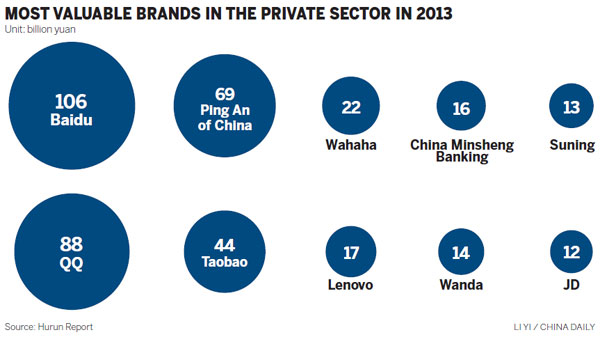Many mainland companies still little-known to shoppers abroad
Privately owned enterprises have seen their brand value increase in the past year as more attention is paid to brand building, according to the Most Valuable Chinese Brands List 2013 released by luxury publishing and events group Hurun Report.

Among the 200 Chinese brands on the list, 98 are privately owned, accounting for most of the shortlisted brands and outnumbering their State-owned counterparts.
The average brand value of these 98 brands was 6.97 billion yuan ($1.13 billion), 2.8 percent less than in last year's Top 100 Privately Owned Brands survey from Hurun Report.
A total of 24 privately owned enterprises were new to the list last year, accounting for 37 percent of all 65 newly listed brands.
Vancl (Beijing) Technology Co, a privately owned online clothing retailer, saw its brand value rise threefold last year, the most rapid growth among all shortlisted brands. Another privately owned enterprise, Hangzhou-based property developer Greentown China Holdings Ltd, saw its brand value double last year, second only to Vancl in terms of its growth.
Although its brand value shrank 28 percent to 106 billion yuan in 2012, Baidu Inc was the most valuable brand among all the shortlisted Chinese private enterprises for the third consecutive year. Tencent QQ was second only to Baidu with a brand value of 88 billion yuan, up 9 percent year-on-year.
The threshold for entering this list was 1.2 billion yuan in 2012, with 200 Chinese enterprises eligible to be shortlisted, double the number in 2011. However, the total brand value of these 200 enterprises, more than 2.8 trillion yuan, was only 11 percent higher than the 100 shortlisted companies in 2011.
The minimum level for entering the top 100 was 3.8 billion yuan, the highest ever since Hurun Report started publishing the list in 2006.
Rupert Hoogewerf, chairman and chief researcher of Hurun Report, said: "Although the value of Chinese brands is increasing slower than I expected, they have invested more in brand building in recent years. They have also come up with a lot of innovations, including the use of new media."
Krys Piotrowski, head of business development at return-on-investment agency ZenithOptimedia China, said: "As the consumer rapidly changes not only their media consumption habits but their expectations from brands, marketers need to evolve their communication strategies."
With a brand value of 251 billion yuan, China Mobile topped all Chinese brands for the second consecutive year. However, its brand value was 9 percent less than in 2011.
A total of 94 State-owned brands were listed among the top 200 most valuable brands. Another eight Chinese brands with foreign holdings, such as Beijing-based Sina Corp and China's largest meat-processing enterprise Shuanghui Group from Henan province, were also found in the top 200.
However, few Chinese brands are known globally. According to the Global Brand Simplicity Index 2012 compiled by global strategic branding firm Siegel Gale, in the catering industry, richer Chinese consumers prefer international chain restaurants while richer consumers in the United States would prefer local restaurant brands.
Jason Cieslak, president of Siegel Gale Pacific Rim, agreed that Chinese consumers would like to use Chinese brands if they are good enough, but they are not doing this at the moment.
Cieslak suggested that Chinese brands should "be bold".
"The world is filled with forgettable brands. Most organizations these days tend to think that the world will notice when their font changes, or their logo has a small tweak. But the truth is, the world doesn't notice and likely doesn't care," he said.
"By bold we mean take a stand in your industry. Define who you are and who you are not. Make the tough decisions about legacy names, sub-brands, messaging and thinking. Think about design as a strategic tool that can redefine how a category is viewed. And focus on your brand experience touchpoints to drive home that any brand relaunch is more than lipstick on the proverbial pig - it's real, meaningful change," he added.
